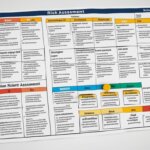Table of Contents
Welcome to our comprehensive guide on risk assessment. In today’s dynamic and unpredictable world, it is essential for organizations to be prepared for potential hazards that could disrupt their operations and compromise the safety of their personnel. A risk assessment is a systematic process that allows organizations to identify and analyze potential risks, with the ultimate goal of mitigating those risks and ensuring a safe and secure working environment.
During a risk assessment, organizations review their processes, operations, and physical locations to identify any potential hazards that could pose a threat to their employees or the continuity of their business. By analyzing the likelihood and severity of each hazard, organizations can prioritize their efforts and implement appropriate measures to control or eliminate the identified risks.
The importance of risk assessment cannot be overstated. By conducting a thorough risk assessment, organizations can proactively identify and address potential hazards, preventing injuries, illnesses, and costly disruptions. Furthermore, risk assessments help organizations comply with legal requirements, create awareness about hazards and risk among employees, and allocate the necessary resources for effective risk management.
Throughout this guide, we will delve deeper into the intricacies of the risk assessment process, exploring the steps involved, the tools used, and the significance of effective risk communication. By the end, you will have a comprehensive understanding of risk assessment and the necessary knowledge to implement a robust risk management strategy within your organization.
What is a Risk Assessment?
A risk assessment is a critical process that allows employers to identify potential hazards within their organization and evaluate the likelihood and severity of these hazards causing harm. By conducting a risk assessment, organizations can gain valuable insights into the risks they face and take appropriate measures to prevent or control them. This process involves hazard identification, risk analysis, and risk control.
Hazard Identification
Hazard identification is the initial step in a risk assessment. It involves systematically identifying potential hazards that could pose a threat to the health and safety of employees or the organization as a whole. Hazards can vary across different industries and workplaces, ranging from work accidents and emergency situations to exposure to toxic chemicals, employee conflicts, and stress.
Risk Analysis
Once potential hazards have been identified, organizations need to analyze the risks associated with each hazard. This involves assessing the likelihood and severity of harm that could occur as a result of exposure to the hazard. Risk analysis helps to determine the level of risk posed by each hazard and prioritize them for further action.
Risk Control
Risk control is about taking appropriate actions to prevent or reduce the risks identified during the risk assessment process. This can include implementing safety measures, providing training and education to employees, modifying work processes or equipment, and establishing protocols and procedures to mitigate the potential hazards. The goal is to create a safe and healthy work environment by minimizing the likelihood and impact of risks.
A comprehensive risk assessment enables organizations to protect the health and safety of their employees, meet legal requirements, and foster a culture of safety within the workplace. By identifying and addressing potential hazards, organizations can reduce the likelihood of accidents, injuries, and illnesses, resulting in a more productive and resilient workforce.
Steps in the Risk Assessment Process
The risk assessment process involves several key steps that organizations should follow to effectively identify and manage hazards. By following a structured approach, organizations can ensure that potential risks and their associated impacts are thoroughly assessed and appropriate control measures are implemented.
Determining the Scope
Before conducting a risk assessment, it is essential to determine the scope of the assessment. This involves clearly defining the processes, activities, functions, and physical locations that will be included in the assessment. By establishing the scope, organizations can ensure that all areas prone to hazards are adequately considered. This may include specific departments, workstations, machinery, or even the entire organization.
Allocating Resources
Allocating the necessary resources is crucial for a successful risk assessment. This includes providing sufficient time, personnel, and financial resources. Organizations should allocate dedicated personnel who possess the necessary expertise and knowledge to conduct the assessment effectively. Adequate financial resources should be allocated to cover any costs associated with implementing control measures identified during the assessment.
Identifying Stakeholders
Engaging stakeholders is vital throughout the risk assessment process. Stakeholders are individuals or groups who have an interest in or can be affected by the outcomes of the assessment. This includes senior leaders, managers, employees, and representatives from relevant departments or teams. Involving stakeholders ensures that their perspectives, expertise, and concerns are considered, leading to a more comprehensive and accurate assessment.
Considering Laws and Regulations
Organizations must consider the laws and regulations applicable to their industry when conducting a risk assessment. Understanding and complying with legal requirements, such as those set by regulatory bodies like the Occupational Safety and Health Administration (OSHA), is essential to ensure the assessment aligns with legal obligations. Compliance with laws and regulations helps organizations create a safer work environment and mitigate potential legal liabilities.
Identifying Hazards
The first step in the risk assessment process is to identify hazards. Hazards can encompass a wide range of potential risks that may cause harm or damage. This can include natural disasters, biological hazards, workplace accidents, intentional acts, technological hazards, chemical hazards, mental hazards, and interruptions in the supply chain. By thoroughly identifying hazards, organizations can develop a comprehensive understanding of the potential risks they face.
| Hazard Type | Description |
|---|---|
| Natural Disasters | Hazards resulting from natural events, such as earthquakes, floods, hurricanes, or wildfires. |
| Biological Hazards | Risks associated with exposure to infectious diseases, bacteria, viruses, or other biological agents. |
| Workplace Accidents | Potential hazards that may cause injuries or accidents in the workplace, such as slips, falls, or machinery-related incidents. |
| Intentional Acts | Possible risks resulting from deliberate acts of sabotage, theft, or violence in the workplace. |
| Technological Hazards | Risks arising from the use of technology, such as equipment failure, malfunctioning software, or cyber threats. |
| Chemical Hazards | Potential risks associated with exposure to hazardous chemicals, such as toxic substances or flammable materials. |
| Mental Hazards | Risks posed by factors affecting mental well-being, such as stress, prolonged work hours, or workplace bullying. |
| Supply Chain Interruptions | Potential risks arising from disruptions in the supply chain, such as natural disasters, economic crises, or logistical challenges. |
Once hazards have been identified, organizations can proceed to the next steps of the risk assessment process, including risk analysis, evaluation, and the development of control measures.
Risk Analysis and Evaluation
After identifying hazards, organizations need to analyze and evaluate the risks associated with each hazard. This involves considering uncertainties, hazards, consequences, likelihood, events, scenarios, controls, and their effectiveness.
“Risk analysis is a fundamental step in the risk assessment process. It allows organizations to quantify and understand the potential risks they face, providing insights into the likelihood and severity of each risk.”
One of the key tools used in risk analysis is a risk assessment matrix. This matrix helps compare and prioritize hazards based on their likelihood and severity, assigning them risk levels and scores.
To illustrate, the risk assessment matrix can be divided into several levels, such as low, medium, and high, to categorize risks accordingly. The likelihood and severity of each hazard are assessed and assigned a score, which determines its risk level. By plotting the hazards on the risk matrix, organizations can visually identify the highest-level risks that require immediate attention and mitigation.

Example of a Risk Assessment Matrix:
| Hazard | Likelihood | Severity | Risk Level |
|---|---|---|---|
| Natural disasters | High | High | High |
| Workplace accidents | Medium | High | High |
| Chemical hazards | Medium | Medium | Medium |
| Interruptions in the supply chain | Low | High | Medium |
| Technological hazards | Low | Low | Low |
Once the risks have been analyzed and assigned risk levels, organizations can move on to risk evaluation, which involves comparing the results of the risk analysis to established risk criteria. This step helps determine if additional controls are necessary and what those controls should be to mitigate the identified risks.
Risk evaluation is crucial for organizations to make informed decisions about allocating resources and implementing effective risk management strategies. By understanding the severity and likelihood of each risk, organizations can prioritize their risk mitigation efforts and ensure the safety and well-being of their employees and stakeholders.
Importance of Risk Communication
Effective risk communication plays a vital role throughout the risk assessment process. It is essential for safety professionals to communicate the identified, analyzed, and evaluated risks to all stakeholders involved.
This transparent communication ensures that everyone within the organization understands the potential hazards and risks, as well as the measures being taken to prevent or mitigate them. By maintaining trust and accountability, risk communication promotes a culture of safety and facilitates effective risk management.
Transparency is key in risk communication. It allows for open dialogue, enabling stakeholders to have a comprehensive understanding of the organization’s risk assessment process. This transparency builds confidence and fosters collaboration among team members, enhancing the overall effectiveness of risk management efforts.
FAQ
What is a risk assessment and why is it important?
A risk assessment is a crucial process for organizations to identify and prepare for potential risks in order to avoid catastrophic consequences and ensure the safety of their personnel. It helps organizations analyze possible threats, prevent injuries or illnesses, meet legal requirements, create awareness about hazards, and determine the budget for risk management.
What does a risk assessment involve?
A risk assessment involves reviewing and evaluating the organization to identify processes and situations that may cause harm, analyzing the likelihood and severity of each hazard, and determining steps to control or eliminate them. It includes hazard identification, risk analysis, and risk control.
What are the steps in the risk assessment process?
The steps in the risk assessment process include determining the scope of the assessment, allocating the necessary resources, identifying stakeholders, considering applicable laws and regulations, and identifying hazards such as natural disasters, workplace accidents, chemical hazards, and others.
How do organizations analyze and evaluate risks?
Organizations analyze and evaluate risks by considering uncertainties, hazards, consequences, likelihood, events, scenarios, controls, and their effectiveness. Tools such as risk assessment matrices and heat maps can be used to compare and prioritize hazards based on likelihood and severity. Risk analysis helps identify the highest-level risks and evaluate existing controls, while risk evaluation compares the results of risk analysis to established criteria to determine if additional controls are necessary.
Why is effective risk communication important?
Effective risk communication is crucial to ensure all stakeholders have a comprehensive understanding of the hazards and risks that exist within the organization. It helps maintain trust and accountability, promotes a culture of safety, and facilitates effective risk management.













